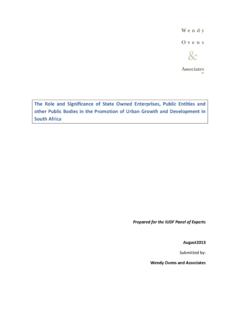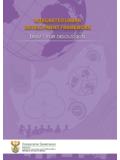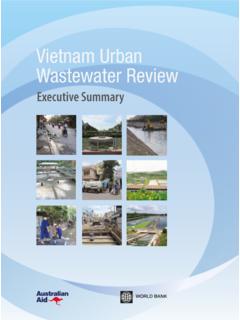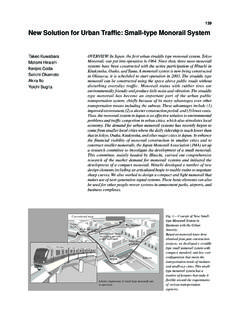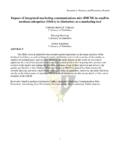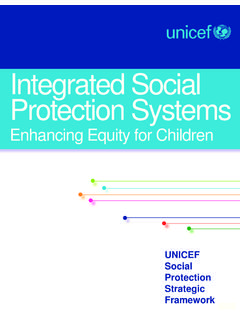Transcription of Integrated Mariculture A Global Review. FAO …
1 529 FAOFISHERIES ANDAQUACULTURETECHNICALPAPERI ntegrated maricultureA Global review 529 FAO Integrated Mariculture A Global reviewISSN 2070-7010 This technical paper provides a comprehensive review of current Integrated Mariculture practices around the world in three papers covering temperate zones, tropical zones and one semi enclosed ecosystem, the Mediterranean Sea. Integrated Mariculture includes a diverse range of co-culture/farming practices, from Integrated multitrophic aquaculture to the more specialized integration of mangrove planting with aquaculture , called aquasilviculture. Modern Integrated Mariculture systems must be developed in order to assist sustainable expansion of the sector in coastal and marine ecosystems thus responding to the Global increase for seafood demand but with a new paradigm of more efficient food production systems.
2 Successful Integrated Mariculture operations must consider all relevant stakeholders into its development plan, there is also a need to facilitate commercialization and promote effective legislation for the support and inclusion of Integrated Mariculture through adequate incentives particularly considering the reduction of environmental costs associated to monoculture farming. Bioremediation of fed aquaculture impacts through Integrated Mariculture is a core benefit but the increase of production, more diverse and secure business and larger profits should not be underestimated as additional 978-92-5-106387-3 ISSN 2070-7010 Cover.
3 Illustration by Doris Mariculture A Global reviewFOOD AND AGRICULTURE ORGANIZATION OF THE UNITED NATIONS Rome, 2009 FAOFISHERIES AnDAquAcultuREtEcHnIcAlPAPER 529 Edited byDoris SotoSenior Fishery Resources Officer ( aquaculture ) aquaculture Management and Conservation Service (FIMA)FAO fisheries and aquaculture Department Rome, Italy The designations employed and the presentation of material in this information product do not imply the expression of any opinion whatsoever on the part of the Food and Agriculture Organization of the United Nations (FAO) concerning the legal or development status of any country, territory, city or area or of its authorities, or concerning the delimitation of its frontiers or boundaries.
4 The mention of specific companies or products of manufacturers, whether or not these have been patented, doesnot imply that these have been endorsed or recommended by FAO in preference to others of a similar nature that are not views expressed in this information product are those of the author(s) and do not necessarily reflect the views of 978-92-5-106387-3 All rights reserved. Reproduction and dissemination of material in this information product for educational or other non-commercial purposes are authorized without any prior written permission from the copyright holders provided the source is fully acknowledged.
5 Reproduction of material in this information product for resale or other commercial purposes is prohibited without written permission of the copyright for such permission should be addressed to:Chief Electronic Publishing Policy and Support BranchCommunication Division FAO Viale delle Terme di Caracalla, 00153 Rome, Italy or by e-mail to: FAO 2009iiiPreparation of this documentConsidering the demonstrated relevance of Integrated aquaculture for livelihoods and environmental sustainability in inland ecosystems, in 2005 the aquaculture Management and Conservation Service (FIMA) of the Food and Agriculture Organization of the United Nations (FAO) fisheries and aquaculture Department began a study on Integrated Mariculture .
6 The main goals were to asses the current practice of Integrated aquaculture and its potential in marine environments envisioning to use this information for the development of technical guidelines. The initial stage of this project included three desk studies encompassing Global views of practices and future prospects for Integrated aquaculture in coastal and marine areas in three climatic zones: temperate, tropical and Mediterranean Sea as a special Mediterranean enclosed ecosystem. Since Integrated aquaculture can be considered a major tool for the implementation of an ecosystem approach to the sector, these Global reviews were also presented and discussed during the Food and Agriculture Organization of the United Nations/Universitat de les Illes Balears Expert Workshop on Building an ecosystem approach to aquaculture convened in Palma de Mallorca, Spain, from 7 11 May 2007.
7 The commissioned review papers describing Integrated aquaculture in coastal and marine environments were technically supervised by Mrs Doris Soto, Senior fisheries Officer (FIMA). The activity and the publication have been partly funded through a Japanese Trust Fund Project (Towards Sustainable aquaculture : Selected Issues and Guidelines).ivAbstractWhile the concept and practice of Integrated aquaculture is well-known in inland environments particularly in Asia, in the marine environment, it has been much less reported. However, in recent years the idea of Integrated aquaculture has been often considered a mitigation approach against the excess nutrients/organic matter generated by intensive aquaculture activities particularly in marine waters.
8 In this context, Integrated multitrophic aquaculture (IMTA) has emerged, where multitrophic refers to the explicit incorporation of species from different trophic positions or nutritional levels in the same system. Integrated marine aquaculture can cover a diverse range of co-culture/farming practices, including IMTA, and even more specialized forms of integration such as mangrove planting with aquaculture , called aquasilviculture. Integrated Mariculture has many benefits, among wich bioremediation is one of the most relevant, and yet is not valued in its real social and economic potential although the present document provides some initial economic estimates for the integration benefits derived from bioremediation.
9 Reducing risks is also an advantage and profitable aspect of farming multiple species in marine environments (as in freshwaters): a diversified product portfolio increases the resilience of the operation, for instance when facing changing prices for one of the farmed species or the accidental catastrophic destruction of a crop. Yet such perspectives are far from been considered in Mariculture where, on the contrary, there is a tendency to Integrated Mariculture systems must be developed in order to assist sustainable expansion of the sector in coastal and marine ecosystems thus responding to the Global increase for seafood demand but with a new paradigm of more efficient food production systems.
10 Successful Integrated Mariculture operations must consider all relevant stakeholders into its development plan government, industry, academia, the general public and non-governmental organizations must work together and the role of Integrated Mariculture within Integrated coastal zone management plans must be clearly defined. There is a need to facilitate commercialization and promote effective legislation for the support and inclusion of Integrated Mariculture through adequate incentives particularly considering the reduction of environmental costs associated to monoculture farming. Bioremediation of fed aquaculture impacts through Integrated aquaculture is a core benefit but the increase of production, more diverse and secure business, and larger profits should not be underestimated as additional many cases, more research is needed to further Integrated Mariculture particularly regarding the technical implementation of a farm.










